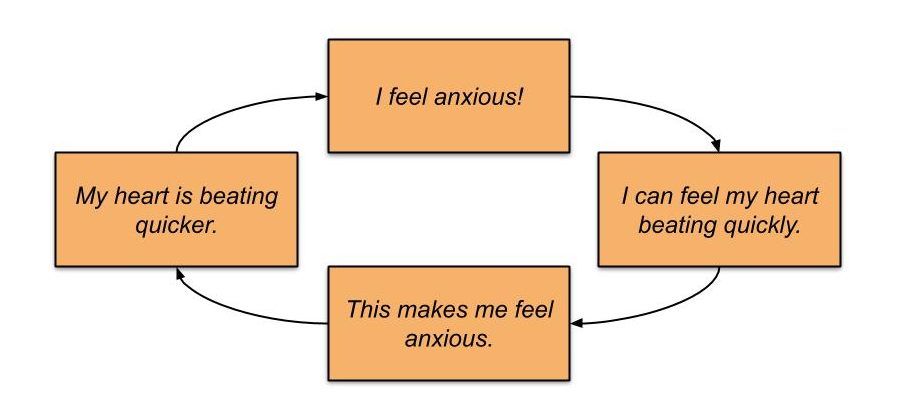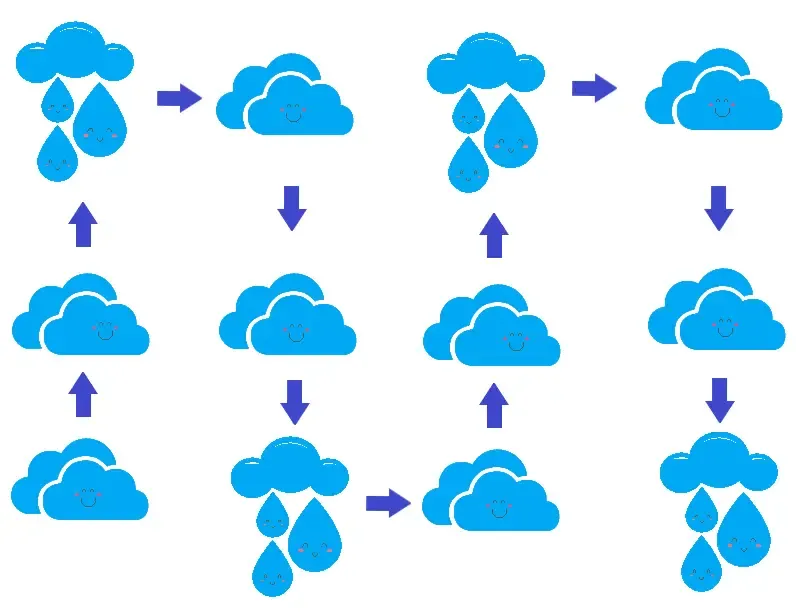10+ Mindful Grounding Techniques (Incl. Group Exercise)
 In this post, we will be…
In this post, we will be…
Oh… are you still here?
Did your thoughts drift?
Are you thinking of something else?
Or are your thoughts hopping from one idea to the next? If you answered yes to any of these questions, then this is the right post to be reading. In this post, we’ll learn more about grounding.
For many good reasons, mindfulness has received significant attention. Maybe you, someone you know, or even a client have begun a journey to develop mindfulness.
One of the most powerful arguments for practicing mindfulness is how easy it is to incorporate into your daily life.
But despite the ease of starting and the benefits of mindfulness, it can be challenging. One of the primary difficulties is the act of ‘staying focused’ during your mindfulness activities. This experience of sustained focus is known as ‘grounding,’ and this post will give you tips on how to do it.
Before you continue, we thought you might like to download our three Mindfulness Exercises for free. These science-based, comprehensive exercises will not only help you cultivate a sense of inner peace throughout your daily life, but will also give you the tools to enhance the mindfulness of your clients, students, or employees.
This Article Contains:
- What Is Grounding in Mindfulness?
- Four Basic Grounding Techniques
- Four Useful Worksheets and PDFs
- Top 4 Grounding Exercises
- Techniques for Managing Anxiety
- Five Ways to Manage Panic Attacks
- Techniques and Exercises for Children
- Two Grounding Exercise Scripts
- Grounding Exercises for Trauma and PTSD
- Mindfulness Exercises and Mindfulness X©
- A Take-Home Message
- References
What Is Grounding in Mindfulness?
Within the field of mindfulness, ‘grounding’ refers to the ability to return to the present moment with sustained attention. For example, while practicing mindfulness meditation, you focus only on your breathing while seated for approximately 10–30 minutes.
Common difficulties when practicing mindfulness
If you have ever tried a meditation session, then you have probably experienced one or many of these common experiences: a wandering mind, boredom, or what’s known as the monkey mind. In all of these experiences, your thoughts are no longer directed toward the task of mindfulness but focused elsewhere instead.
Yates, Immergut, and Graves (2017, p. 89) provide the following comparison of the monkey mind and the wandering mind:
‘Monkey mind’ describes an especially agitated state where attention jumps rapidly from one thing to the next, like an excited monkey. This is quite different from mind-wandering, which happens at a slower pace.
Even if you haven’t experienced the monkey mind while meditating, you might have experienced something similar during periods of extreme stress or anxiety where you feel like your thoughts are racing and you can’t concentrate. Similarly, you might have experienced a wandering mind while performing other tasks, such as reading or driving.
Keep the (monkey) mind grounded
One of the most useful tools in the practitioner’s toolbox, grounding is effective at combating difficulties experienced while practicing mindfulness. You can use grounding techniques to stay in the moment and focus on the current situation while practicing your mindfulness activities.
In some therapeutic fields, grounding techniques are so effective that they can be implemented in situations where people dissociate due to extreme trauma or stress (Zerubavel & Messman-Moore, 2013). Grounding techniques are beneficial for focused attention meditation practices where the mindful practitioner intentionally directs their attention toward an item of focus (Fan, McCandliss, Sommer, Raz, & Posner, 2002).
Four Basic Grounding Techniques

The most basic techniques, which form the foundation of your mindfulness toolbox, include (1) intentionally choosing an object to direct your attention toward, which can be (2) a body scan, (3) focusing on your breath, or (4) becoming aware of external stimuli.
Being aware of drifting thoughts
The most important technique is being aware of what your mind is doing. If you are not aware that your mind is drifting or you have lost your train of thought, then you will not be able to implement the four basic grounding techniques listed above.
When you find that you are distracted and your mind has been wandering, try the following:
- Observe that your thoughts were drifting.
- Do not judge or evaluate that your thoughts were drifting. This is normal and does not mean that you are ‘bad’ at mindfulness.
- Perform one of the four techniques below to help ground you during your mindfulness practice.
Direct your attention toward an object of focus
To stay grounded, choose an object to intentionally direct your attention toward. This object doesn’t necessarily have to be external; it can be anything that you find useful in that moment.
Examples might include your breath, your body, or an external stimulus. Your choice of stimulus depends on the environment and the type of activity you are performing. The next three techniques include an object of focus.
Body scan
During a body scan, you intentionally focus on different parts of your body. For example, if you are seated, then you might focus on the parts of your body that make contact with the ground or the chair. You will then shift your attention to other parts of your body. This can be done in a systematic way such as scanning your body from your toes to head or by following the sensations that you experience.
Focus on your breath
In this technique, you will intentionally focus on your breathing. Your aim is to maintain your focus on controlled inhalation and exhalation and to count your breaths. This technique sounds easy, but it is surprisingly tricky!
Begin by shifting your focus to your breath, inhale for three seconds, and then exhale for three seconds.
Yates et al. (2017) reframe this technique slightly and re-label it as ‘following the breath.’ They further divide up this task into the following challenges:
- Try to find the exact moment at which your inhalation begins and ends.
- Try to find the exact moment at which your exhalation begins and ends.
- Continuously track these start and endpoints with equal concentration and attention.
Becoming aware of external stimuli
This technique is especially useful in situations when you are focusing on objects in the environment. For example, when you can feel that your mind is dancing around or you are struggling to focus, you can intentionally shift your focus to something external in your environment.
Imagine you have a small stone in your hand. You can run your fingers over the stone and concentrate on:
- The texture (is it smooth or rough?)
- The temperature (does it feel cold or is it slightly warm?)
- The shape (is it round or does it have jagged edges?)
Other examples of external points of focus that could be useful include the following:
- When eating mindfully, you might concentrate on the taste and the texture of the food.
- When listening to music, you can concentrate on the notes and the instruments.
- When exercising mindfully, you can focus on the smells and sounds around you.
The 5-4-3-2-1 method: a grounding exercise to manage anxiety – The Partnership in Education
Four Useful Worksheets and PDFs
To assist with practical applications of grounding techniques, try the following useful worksheets.
Mental, physical, and soothing grounding techniques
Winona State University constructed a useful grounding technique PDF compiled from the information provided in Najavits (2007). There are three types of grounding techniques offered here:
- Mental
- Physical
- Soothing
These three types of techniques rely on different mechanisms, and there are a variety of exercises described for each.
- Mental grounding techniques use methods that are primarily of a psychological and cognitive nature; for example, counting slowly or reimagining a previous experience in great detail.
- Physical grounding techniques use methods focused on external stimuli, such as sensations and perceptions related to information that exists in the external environment; for example, exercises such as stretching or yoga, concentrating on tactile sensations such as putting your hands under running water, or rubbing your fingers across different fabrics.
- Soothing grounding techniques describe methods that use kindness and positive sentiment to help induce a sense of calm and relaxation. Examples include thinking of people whom you love or repeating a positive statement to yourself.
Further examples of physical and mental grounding techniques
The Trauma Awareness & Resilience Training Institute for Youth Workers offers a PDF in which the authors provide a helpful distinction between physical and mental grounding techniques.
Below are some extracts from the PDF:
| Physical grounding techniques | Mental grounding techniques |
|---|---|
| Dig your heels into the floor. Remind yourself that you are connected to the ground. | Play a category game. Try to think of TV shows, songs, ice cream flavors… |
| Clench and release your fists. | Remember the words to an inspiring song, mindfulness quote, prayer, or poem. |
| Eat or drink something. Describe the flavors or notice the temperature in detail. | Visualize a place that is calming and safe. |
General grounding techniques
The following three PDFs offer a variety of different types of grounding techniques that you can implement in your personal life, classroom, or clinical practice.
The first PDF contains six exercises compiled by the University of Lethbridge. In the second PDF, James Madison University provides a list of general grounding techniques. These techniques are not grouped into different domains, such as mental, physical, or soothing (rather, they all seem to be physical).
Overall, there are 27 exercises, and they can be used in various environments. Finally, the Counselling and Psychological Services at the University of Sydney compiled a list of more than 10 exercises that can be used for grounding. We will pick our favorite practices and describe them in the next section.
Top 4 Grounding Exercises

Exercise 1: Press your feet into the ground
One of the most straightforward grounding techniques to implement is pressing your heels into the ground and feeling your feet connect to the ground.
Splay your toes and press down into the floor, with equal pressure from your big toe to your baby toe, from the front of your foot to the back of your heel. Feel how your foot connects to the ground and how the ground exerts a constant pressure back toward your foot.
This exercise can be easily implemented in a classroom, clinical practice, or at home/work.
Exercise 2: Concentrate on your breath
Another easy grounding exercise is to concentrate on your breathing.
Sit in a comfortable position, close your eyes, and slowly inhale through your nose for three seconds. Try to inhale in an even controlled manner. Feel the air enter your nose, and try to identify when your inhalation begins and when it ends.
Next, exhale in a controlled manner for three seconds through your mouth. Feel your breath exit your lungs and escape through your lips. Try to identify when your exhalation begins and ends.
Concentrate on your breath, counting your inhalations and exhalations. Try not to let your thoughts drift elsewhere. Try to perform this exercise for three minutes. Like the previous one, this exercise can be used at home/work, in a classroom, or clinical practice.
Exercise 3: Reorientation
During this exercise, the aim is to reorient yourself in your environment. Keep still and take your time to do the following:
- Look around and observe your environment. Notice the light, colors, smells, and sounds.
- Now, name five items that you can see, five things that you can hear, and five things you can feel.
- Repeat the exercise by naming a further four items that you can see, four items that you can hear, and four items you can feel.
- Continue to this exercise for an additional three, two, and then one item that you can see, hear, and feel in your environment.
Although this exercise can be used in all the same scenarios as the previous ones, it may be particularly beneficial in a classroom setting because it is less abstract.
Exercise 4: Group clap
If you’re leading a group session and looking for an easy grounding technique to include, try bringing everyone into the present moment with a group clap. The specifics can vary, but essentially, you get the group counting and clapping together.
Depending on the group, you may clap on every count or only on the agreed upon number/s. For example, have the group count to four repeatedly, clapping only on the one and three.
Techniques for Managing Anxiety
Grounding techniques can be handy for dealing with general anxiety or episodes when you experience intense anxiety, such as before an exam or when encountering a phobia.
The symptoms of anxiety vary significantly between people. In general, anxiety typically presents with a feeling of restlessness, becoming tired quite quickly, struggling to concentrate, feeling irritable, feeling tense, and having sleep disturbances (American Psychiatric Association, 2013).
Some of the grounding techniques that are especially effective include:
- Breathing exercises like the ones described above. Mindfulness exercises with a breathing component are effective at reducing anxiety in phobic situations (Hooper, Davies, Davies, & McHugh, 2011) as well as stress and anxiety associated with medical conditions such as polycystic ovary syndrome (Stefanaki et al., 2015).
- When you are not feeling anxiety, make a list of positive affirmations (e.g., ‘You are strong,’ or ‘You can breathe’). Keep this list on your person or in your bag so that when you are feeling especially anxious, you can focus on the statements and what they mean (Rape Crisis England & Wales, n.d.).
- Another effective grounding technique is one that helps you to remain oriented in your surroundings. Use the re-orientation exercise described above to help maintain your focus and awareness of your surroundings.
- There is some evidence that coloring activities are effective at managing anxiety among university students (Curry & Kasser, 2005) and children (Carsley, Heath, & Fajnerova, 2015). These techniques could be implemented before a test or other stressful events (e.g., performing on stage or participating in a sports activity).
Five Ways to Manage Panic Attacks
For people who experience panic attacks, the experience can be terrifying. During a panic attack, commonly reported symptoms include feeling like one cannot breathe, heart palpitations, dizziness, and sweating. Panic attacks can be extremely distressing experiences.
Mindfulness, and especially grounding techniques, are useful behaviors for people who experience panic attacks.
Some of the grounding techniques, which are often used in conjunction with mindfulness activities, can be extremely useful for managing anxiety and panic attacks (Kim et al., 2016). This is because grounding techniques result in heightened attention and focus, rather than the feedback loop that occurs with anxiety.
Anxiety Feedback Loop
In more extreme situations, when panic attacks appear alongside co-morbid heart disease, mindfulness and grounding techniques are extremely powerful.
For example, Tully, Sardinha, and Nardi (2017) describe a novel action plan for patients who experience panic attacks and have a co-morbid heart disease. In their action plan, they recommend the following when experiencing chest pain:
- Stop and rest.
- Tell someone how you feel.
- Acknowledge the symptoms.
- Start a mindfulness-based stress reduction exercise.
- After a predetermined time limit, decide whether to call an ambulance.
The benefits of the mindfulness exercise in Step 4 are two-fold. First, it helps patients differentiate between threatening and nonthreatening chest pains. Second, if the chest pains are threatening, then patients have started a stress reduction exercise that may help them manage their anxiety.
In addition to these recommendations, Kissen, Kendall, Lozano, and Ioffe (2020) also suggest the following for people who experience panic attacks: Patients should make a note of the signs that a panic attack is imminent and make a small note next to each grounding technique about when it should be used.
For example, if the patient finds that the breathing technique is most useful in the early stages of a panic attack, then patients could write something along the lines of “Use when starting feel symptoms of a panic attack.” This means they can easily rely on the task instead of trying to make a choice when there is limited time to spare.
Techniques and Exercises for Children

Teachers and therapists can use coloring exercises to help with grounding, especially before a stressful event like a test, performance, or sporting event.
Not all coloring exercises are equally effective. Carsley et al. (2015) found that boys were more relaxed after a free-form coloring exercise, whereas girls responded better to structured coloring activities such as mandalas.
Other useful techniques include:
- In a version of the reorientation exercise called the 5-4-3-2-1 Senses Game, children must find five objects in their environment that they can see, then four items they hear, three items that can smell, two that they can touch, and one item that they can taste.
- These games can be modified so that they’re easier or more difficult, depending on the age of the child and size of the group. For example, smaller children might perform better with a game that focuses on only items/colors/shapes/textures/people/animals that they can see. At each step, children can be asked to identify a different type of item (e.g., five colors, four shapes, and so forth).
- Physical exercises such as imitating a tree can be useful. Legs can be planted firmly on the ground, backs straight, and arms stretched out wide. Children can be asked to pretend to be a tree swaying in the wind or a strong tree that doesn’t move. The physical act of drawing awareness to their bodies can be effective at focusing their attention.
- Another useful physical exercise is to practice slow, careful breathing. Children could be given a simple template where inhalations and exhalations are indicated by puffs of clouds and raindrops respectively, and must follow the path to help with their breathing.
Two Grounding Exercise Scripts
Sometimes it is difficult to implement grounding techniques without guidance. Knowing this, we have provided a few scripts for you to use. These grounding scripts can be easily adapted as needed.
Meditation grounding script
This script was adapted from Haseman (2018).
- Begin by instructing the patient to close their eyes.
- Instruct the patient to inhale and exhale for a set number of counts (e.g., inhale for six counts, exhale for six counts). For younger children, the number of counts should be fewer.
- Direct the patient’s attention to their body. Help the patient to scan their body from top to bottom, looking for signs of stress or tension. If they find any tension, have them direct their attention to this body part, pause, and release the tension on an exhale.
- Move the patient’s attention to how their weight is distributed through the body and where their body connects with the ground.
- Draw their attention back to the breath and follow the counts. Let the patient continue breathing on their own.
- At various intervals, direct the patient’s attention to their limbs, fingers, toes, and back to their breath, slowly guiding them.
- After a few minutes, slowly guide the patient back by redirecting their attention away from internal awareness to the external sounds in their environment.
Meditation grounding script for children
This grounding script is more useful for children, especially before tests. I’ve provided two versions, one for older children and a modified version for younger children. Both scripts can be used to guide children through meditation. For both, begin the meditation with them seated on the ground with eyes closed.
Grounding Exercises for Trauma and PTSD

Vujanovic, Niles, Pietrefesa, Schmertz, and Potter (2013) posit a convincing argument about people with PTSD.
- They are better able to engage with therapy when they are also able to engage with the present moment.
- They are better able to manage psychological anxiety, arousal, and stress when feeling grounded.
- Grounding exercises help patients decide if they need to shift their attention away from their internal thoughts and feelings toward another, different item of focus.
Batten, Orsillo, and Walser (2005) offer the following useful exercises for people who experience trauma and PTSD:
- Mindful breathing exercises (like those described previously)
- Techniques of self-soothing using the five senses (similar to the reorientation exercise)
These techniques help patients redirect their attention away from events and thoughts that are triggering their symptoms toward a ‘safer’ space where they can react in a more meaningful, controlled manner. At later stages in patients’ therapeutic journeys, these techniques can be combined with other effective strategies.
Patients who experience trauma and PTSD can also use the techniques and exercises for those who experience anxiety and panic attacks. The techniques in those sections can be beneficial for acute experiences of trauma.
Mindfulness Exercises and Mindfulness X©
At PositivePsychology.com, we have many tools that can help you with grounding techniques.
- The Breath Awareness exercise is a guided exercise that will help you or your client to redirect their attention toward the present moment by focusing on their breath.
- The 3-Step Mindfulness Worksheet is a simple exercise that can be performed anywhere. Informal meditation such as this can be extremely useful if you don’t have time for formal mindfulness practice. In this exercise, you follow three steps to bring your awareness to the present moment: step out of autopilot, become aware of your breath, and expand your awareness outward.
- Practitioners who are helping their clients manage stress and anxiety will enjoy the Creating A Mindfulness Anxiety Plan worksheet, which can be used to help clients craft a mindfulness plan for their anxiety triggers.
Finally, you can also invest your time in attending the online Mindfulness X© Masterclass. Not only will you obtain science-based training templates to use in your practice to teach mindfulness, but you will gain in-depth training and knowledge to become a mindfulness trainer, coach, or practitioner.
A Take-Home Message
These numerous, useful, easy-to-use grounding techniques can be implemented in your home, classroom, or practice.
If you struggle to decide which technique to use, remember, through the act of grounding, the individual intentionally directs their attention to the present moment by focusing on an item, feeling, sensation, or thought.
With this simple definition in mind, you can easily adapt any of the techniques and exercises to better suit your lifestyle, time, classroom, or therapeutic style.
Grounding techniques are compelling and work well to counteract the intense, negative sensations of anxiety, panic, trauma, and stress.
We hope you enjoyed reading this article. Don’t forget to download our three Mindfulness Exercises for free.
- American Psychiatric Association. (2013). Diagnostic and statistical manual of mental disorders (5th ed.). American Psychiatric Association.
- Carsley, D., Heath, N. L., & Fajnerova, S. (2015). Effectiveness of a classroom mindfulness coloring activity for test anxiety in children. Journal of Applied School Psychology, 31(3), 239–255.
- Batten, S. V., Orsillo, S. M., & Walser, R. D. (2005). Acceptance and mindfulness-based approaches to the treatment of posttraumatic stress disorder. In S. M. Orsillo & L. Roemer (Eds.), Series in anxiety and related disorders. Acceptance and mindfulness-based approaches to anxiety: Conceptualization and treatment (pp. 241–269). Springer.
- Curry, N. A., & Kasser, T. (2005). Can coloring mandalas reduce anxiety? Art Therapy, 22(2), 81–85.
- Fan, J., McCandliss, B. D., Sommer, T., Raz, A., & Posner, M. I. (2002). Testing the efficiency and independence of attentional networks. Journal of Cognitive Neuroscience, 14(3), 340–347.
- Haseman, M. (2018). Sky & Earth: Grounding meditation. Retrieved June 10, 2020, from https://static1.squarespace.com/static/57dc9d2bd1758eccab16078f/t/5c900ec915fcc05609e96cfd/1552944843067/Sky+and+Earth+Grounding+Meditation+Script.pdf
- Hooper, N., Davies, N., Davies, L., & McHugh, L. (2011). Comparing thought suppression and mindfulness as coping techniques for spider fear. Consciousness and Cognition, 20(4), 1824–1830.
- Kim, M. K., Lee, K. S., Kim, B., Choi, T. K., & Lee, S. H. (2016). Impact of mindfulness-based cognitive therapy on intolerance of uncertainty in patients with panic disorder. Psychiatry Investigation, 13(2), 196–202.
- Kissen, D., Kendall, A. D., Lozano, M., & Ioffe, M. (2020). Rewire your anxious brain for teens: Using CBT, neuroscience, and mindfulness to help you end anxiety, panic, and worry. New Harbinger Publications.
- Najavits, L. M. (2007). Seeking safety: An evidence-based model for substance abuse and trauma/PTSD. In K. A. Witkiewitz & G. A. Marlatt (Eds.), Practical resources for the mental health professional. Therapist’s guide to evidence-based relapse prevention (pp. 141–167). Elsevier Academic Press
- Rape Crisis England & Wales. (n.d.) Grounding. Rape Crisis England & Wales. Retrieved June 10, 2020 from https://rapecrisis.org.uk/get-help/looking-for-tools-to-help-you-cope/grounding/grounding-techniques/
- Stefanaki, C., Bacopoulou, F., Livadas, S., Kandaraki, A., Karachalios, A., Chrousos, G. P., & Diamanti-Kandarakis, E. (2015). Impact of a mindfulness stress management program on stress, anxiety, depression, and quality of life in women with polycystic ovary syndrome: A randomized controlled trial. Stress, 18(1), 57–66.
- Tully, P. J., Sardinha, A., & Nardi, A. E. (2017). A new CBT model of panic attack treatment in comorbid heart diseases (PATCHD): How to calm an anxious heart and mind. Cognitive and Behavioral Practice, 24(3), 329–341.
- Vujanovic, A. A., Niles, B., Pietrefesa, A., Schmertz, S. K., & Potter, C. M. (2013). Mindfulness in the treatment of posttraumatic stress disorder among military veterans. Professional Psychology Research and Practice, 42(1), 24–31.
- Yates, J., Immergut, M., & Graves, J. (2017). The mind illuminated: A complete meditation guide integrating Buddhist wisdom and brain science for greater mindfulness. Simon and Schuster.
- Zerubavel, N., & Messman-Moore, T. L. (2013). Staying present: Incorporating mindfulness into therapy for dissociation. Mindfulness, 6(2), 303–314.
Let us know your thoughts
Read other articles by their category
- Body & Brain (42)
- Coaching & Application (54)
- Compassion (26)
- Counseling (50)
- Emotional Intelligence (24)
- Gratitude (18)
- Grief & Bereavement (21)
- Happiness & SWB (39)
- Meaning & Values (25)
- Meditation (20)
- Mindfulness (44)
- Motivation & Goals (43)
- Optimism & Mindset (32)
- Positive CBT (25)
- Positive Communication (20)
- Positive Education (44)
- Positive Emotions (30)
- Positive Leadership (13)
- Positive Psychology (32)
- Positive Workplace (33)
- Productivity (16)
- Relationships (41)
- Resilience & Coping (34)
- Self Awareness (20)
- Self Esteem (36)
- Software & Apps (13)
- Strengths & Virtues (30)
- Stress & Burnout Prevention (33)
- Theory & Books (44)
- Therapy Exercises (35)
- Types of Therapy (58)






What our readers think
I am quite impressed with the content and layout of your website. I will pass it along. I am wondering if you could clarify something for me. Many years ago in my meditation and intuition training, I was taught to focus my mental attention, specifically in my 6th chakra. From there I would look at or experience, my inner and outer observations. I don’t hear or read about the experiencing of the sensations of one’s mental focus? Any insight would be appreciated. Best, Tom Rohrer, PhD, MFT
Hi Dr. Rohrer,
Thank you for your kind words and for passing along our website!
You raise an interesting point about the sensations of mental focus, particularly in the context of meditation and the 6th chakra, or “third eye”.
When we talk about ‘experiencing the sensations of one’s mental focus,’ we’re delving into a subtle and deeply personal realm. Different people may describe these sensations differently: as a pressure, a warmth, a vibration, or even as a color or sound. These experiences can be elusive, and their description isn’t as common in the mainstream discourse on meditation.
For a deeper dive into this topic, I recommend exploring these two articles: “Mindfulness meditation training alters cortical representations of interoceptive attention” by Farb and colleagues (2013), and “The multidimensional assessment of interoceptive awareness (MAIA)” by Mehling and colleagues (2012).
I hope this helps!
Kind regards,
Julia | Community Manager